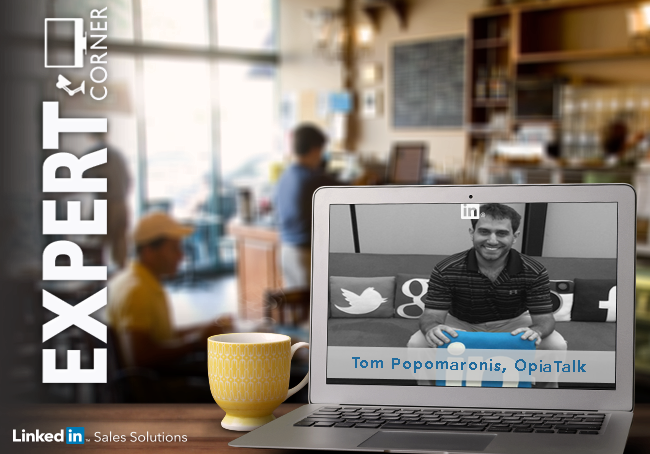LinkedIn Sales Insights best practices and customer stories
Be Fearless: How We Used LinkedIn to Launch Our Start Up Part 1
The first time I used LinkedIn, I didn’t really like it. I saw it as a sort of Facebook for professionals, and didn’t grasp its differentiating value. I certainly didn’t see how it could help my startup on a concrete level, right now.
At the time, that startup was Auctionopia, a social marketplace like eBay, only with no fees and a cool IM feature so buyers and sellers could haggle in real time.
Then, in June of 2012, our team attended the Internet Retailer Conference and Exhibition(IRCE). Post-conference, I had a long list of e-commerce professionals with whom I wanted to stay in touch, and LinkedIn was the obvious way to do so. Little did I know I’d only just scratched the surface of its utility.
Retailers began giving us the consistent feedback that of everything about Auctionopia, the feature they liked the most was the social experience it provided via the live IM function. However, they wanted it to somehow be embedded on their own sites, rather than directing traffic to a third party site.
In true startup fashion, we pivoted. We started developing OpiaTalk into what retailers said they wanted, and what it is today: a hyper-conversion widget (demo here) that sits on a retailer’s site, driving 8-10% conversion of organic traffic (4-5x industry average). In addition to conversions, we also developed it to drive incremental data and opted-in leads, all on a revenue sharing basis -- we only make money when the retailer does.
Even at the beginning of this process, I knew we were going to need feedback. We needed technical expertise to extract the widget correctly, and industry expertise to develop it right. In other words, I knew I didn’t know enough to create exactly the right product – alone.
Given the caliber of people I now knew were on Linked, I began to turn to look there for help. I could never have predicted that the actions taken in the ensuing months would lead to us pulling in our Chairman of the Board, entire Advisory Board, and first paying enterprise client.
This is how we did it, and how you can too.
1. Start Early
Everyone always tells you to test early and get feedback. Pre-validation is the new normal. But especially if you’re B2B, it can be difficult to gain access to your target market (or a wide enough array for it to make sense). Sure, it’d be great to ask the current or former CMO of Gap what they think, but how are you going to get access to that person?
When we first pivoted from Auctionopia to OpiaTalk, I knew I needed to be sitting across from actual e-commerce directors, asking things like, “What’s good about this? Why would you not use it?” The problem was, I didn’t know anyone at that level. I needed people way up the chain – those with real decision-making capabilities. I had to know if they would say yes, because they were our target market.
Enter LinkedIn. I began reaching out to leaders in the industry, with a genuine question. At the beginning, we didn’t even have the product fully developed. I just sent this videoand basically said, “Hey, we’re building this. What do you think?”
In fact, many of you reading this may recall a friendly little message from me. Truly, thank you all for taking the time to even read and provide feedback. It provided incredible insights into what we were building at the time.
Write to top leaders about your product as soon as you possibly can. You can’t count on a response from everyone, but you can bet that the ones you do get will be valuable, and potentially invaluable.
2. Invest In InMail
I can’t stress this one enough.
If you’re not already connected to someone on LinkedIn, you must send them an InMail if you want to get in touch. I wasn’t yet connected to the high-ups in my field, so I started sending them.
A lot of them.
The advantage of InMail is that you only pay for those you get a response to. If the person doesn’t respond within a week, the InMail returns to you, available to be sent to someone else. Perhaps most importantly, there’s a potentially exponential ROI if someone does respond. The people I sent them to were cultivated; I selected them specifically because of their expertise and experience. Every time I got a response I wasthrilled, because I was only sending them to ballers in the industry.
I was also thrilled and, in fact, a bit surprised at the number of responses: I got close to a 20% response rate. One in five people wrote back, and many, many of those went on to become mentors, advisors, friends, or at least respected connections.
A single InMail costs $10, and I think there’s some hesitation to pay for them. There’s also the fear that because it’s a ‘cold’ reach-out, it will only ever be perceived as a sales pitch. It probably will be perceived as a sales pitch … if it’s a sales pitch. But if it’s a short, genuine note seeking feedback, I’ve found that it works incredibly well. In fact, it was an InMail that led to us landing our first paying enterprise client.
To date, I’ve sent over 1,000 InMails and OpenLink messages (if someone allowsOpenLink messages, you don’t need to purchase an InMail to contact them). I’ve invested close to $750 in InMails alone, which I see as a small price to pay for the invaluable network of which I count myself as fortunate to be a part.
You have the tools to get connected to relevant thought leaders, right now. Use InMail to go on the offensive.
3. Use Job Postings
A major turning point for OpiaTalk was when I listed our first job for Chief Technology Advisor. We needed someone to help us extract the technology quickly and efficiently, and given the quality of those on LinkedIn, I thought it could potentially help us find the person.
I got more than I could ever have imagined.
One of the applicants was Joseph Seibert, former CIO of the New York Times, GSI Commerce, and CBS/Viacom. I was incredibly impressed by his background, and we clicked immediately. I felt like Joe ‘got’ what we were doing in a way few others had, and with his deep experience in the field, he offered immense value. After a few more meetings, we made the relationship official – he became our Chief Technology Advisor. The connections, industry expertise, and mentorship he provides are priceless, and I’m proud to report that Joe is now our Chairman of the Board.
Of note is that in the original job description, we were clear about what we were looking for. We were a startup with limited cash to throw around, so we were seeking a Chief Technology Advisor, not Officer.
It’s OK to be upfront about listing advisory positions where cash is limited (or nonexistent), but the potential for equity could be on the table. Be transparent about what you can offer, and know that those with background in the industry and startups will understand. Many are looking for new and exciting opportunities; if they see value in what you are creating, they’ll want to be a part of it.
A job listing on LinkedIn costs $195-395, depending on your geographic region. For us, it was one of the best investments we ever made – I doubt we would have found Joe any other way. We were a tiny startup with limited exposure, looking for industry leaders with deep experience to be on our side. If you, too, need champions, advisors, people who will be in your corner and help you develop from the inside out, it’s worth investing to get those people.
4. Be Fearless
Professionals from all industries and all walks of life convene on LinkedIn. The place is a veritable Who’s Who of those in e-commerce, technology, venture capital, healthcare, entertainment, education, publishing, real estate, HR – you name it. Arianna Huffington is on it; Richard Branson is on it; Meg Whitman is on it; Mark Cuban is on it. YOU are on it.
Remember that you have something to offer, even if you’re not yet established. People are often looking for new and interesting things to be a part of, and as startups, that’s part of our value add. Creativity is what makes life exciting, and by definition, startups strive to create something new, something exciting, something relevant. That, in and of itself, is engaging.
So get out there, and make LinkedIn work for you.You’ve got something to give, and you’ve got something to gain. Don’t assume someone won’t write back – assume they will. Be polite, but take chances. You never know who will respond, or where that will lead you. Be fearless. You’ve got nowhere to go but up.
--------
I can’t really express how much LinkedIn has impacted our startup. We would absolutelynot be where we are today without it, and I’ll continue to use it to build and strengthen our company.
I’ll also be sharing as much as I can about how I’m doing it, because I believe in the power of community. Bringing together behemoths in the industry with those who need them most, only serves everyone. The more we become interconnected, the stronger we all become.
LinkedIn makes it possible for all of us to connect with those we’d never have access to in ‘real’ life. I recommend taking advantage of that. In fact, I strongly “endorse” it (see what I did there?).
Topics: LinkedIn Sales Insights best practices and customer stories
Related articles




